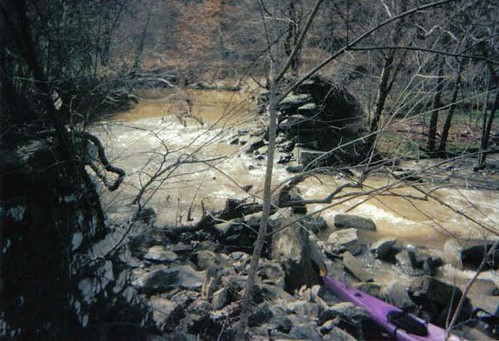In any case, the subject of this sketch was born in 1799 in County Down, Ireland, at Ballylesson. The younger Alexander Wilson grew up in Ireland, studying to become a physician. Around 1817 he graduated from Apothecaries Hall, Dublin. Wilson probably married shortly after graduation. In July 1818 he immigrated to America. Some sources say he lived for a time in New York and taught school there, but others say that North Carolina was his only state of residence in America.
Soon his wife, Mary, came to America as well and about 1820 they were in Raleigh, North Carolina. Wilson taught under Rev. William McPheeters at Raleigh Academy for a year, but then took up teaching in 1821 in Granville County at Williamsboro Academy. In 1826, Wilson was granted his United States citizenship by the Granville County Court. Wilson worked for many years in Granville County, living in Oak Hill. He was the Presbyterian minister to several congregations, including Grassy Creek Presbyterian (which moved and is now Oak Hill Presb.) and Nut Bush Presbyterian which was in the community of Williamsboro. Williamsboro is now called ___ and is in that part of old Granville County which is Vance County today. Rev. Wilson also attended the 1833 founding of Geneva Presbyterian Church in Granville County, as well as probably others.
Rev. Wilson’s work in Granville County was done under the auspices of the New Hope Presbytery. Later, Rev. Wilson became involved in the Orange Presbytery. I don’t know whether this reflects any ideological difference between these Presbyteries. The Grassy Creek Presbyterian Church history notes: “[T]he first African Americans admitted into membership of the Church was between 1833-34. In 1835 service began to be held also in a meeting house between Oak Hill and the Virginia Line, near the residence of the late Graham E. Royster.” This change occurred shortly before Wilson left the New Hope Presbytery, but it is unclear whether these events are related.
In 1833 the Orange Presbytery appointed Rev. Wilson to a committee on Presbyterian education, along with UNC Pres. David Caldwell and a number of others. The committee concluded that a Presbyterian school was needed. The Presbytery concurred and the Caldwell Institute was founded in Greensboro in 1836 with Rev. Wilson as Principal. Mary Wilson initially remained in Granville County, but probably moved to Greensboro around 1837 or 1838.
Around 1845 there was apparently an epidemic in Greensboro and so it was decided to move the school. In the summer of 1845 the Presbytery decided to move the school to Hillsborough and Rev. Wilson moved with the school. About 1850, the Caldwell Institute moved again to the vicinity of Little River Presbyterian Church northeast of Hillsborough, but Wilson did not move with it.
Rev. Wilson’s sons were James, Robert and Alexander, Jr. Robert and Alexander helped teach at their father’s school. Maj. James W. Wilson became a railroad commissioner and Robert Wilson became a businessman in Richmond, Virginia. The Wilson’s also had two daughters, one of whom died young and the other of whom, Alice E. Wilson, married Edwin A. Heartt in late 1847 (Q-H/709), the son of Hillsboro Recorder editor Dennis Heartt.
Right about the same time that Alice Wilson and Edwin Heartt were married, Rev. Wilson, his son Alexander, Jr. and Edwin Heartt bought 50 acres just north of Swepsonville in the community then known as Burnt Shop (ODB 33, pp 101-104). This site was formerly part of 300 acres conveyed from Samuel Child to John W. Norwood (deed not recorded) and was east of the land of the widow of Stephen Glass. At the same time, John A. Bingham bought an additional 50 acres, also formerly part of the Child-Norwood tract.
In 1851, Rev. Wilson founded his own three-room school in Burnt Shop. It is has been claimed that Henderson Scott of the Hawfields was influential in getting Wilson to choose Burnt Shop as the location for the school. If so, then those conversations must have been on-going almost from the moment that Rev. Wilson moved to Hillsborough. In any case, Wilson renamed the community after the Scotch theologian Andrew Melville. The Alexander Wilson School or Melville School became the primary fixture of Melville and earned a reputation as an excellent school. Rev. Wilson also built a gristmill on Haw Creek under the supervision of millwright Berry Davidson. However the dam was ruptured in a great flood in 1875. The remains of the dam can still be seen about 1 mile downstream of the NC 54 bridge over Haw Creek:

Rev. Wilson’s students included several members of the Morehead family, Turner Tate, Tom Roulhac, John and James Wilson, William Mebane, T. B. Bailey, John W. and Geo. Bason, L. Banks Holt, Lawrence Holt, Samuel K. Scott, J. R. Newlin, and Mayor Van Wyck, of New York. After his death in 1867, the school soon closed, but the community is still known as Melville today; and the modern public school in Melville is still called the Alexander Wilson Elementary School.
No comments:
Post a Comment